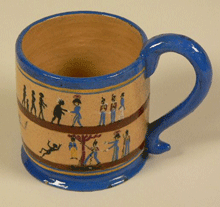
by Violet Mace, Bothwell, Tasmania
In 2005 the National Museum of Australia acquired a decorated and glazed ceramic cup made by Tasmanian potter Violet Mace. Created in 1934 and sometimes referred to as the 'proclamation cup' (Fig. 1), this small wheel-thrown earthenware cup is hand-painted with a series of images clearly derivative of those found in the sequence of scenes that depict Aborigines, British military and convicts from the well-known proclamation boards distributed by Governor George Arthur in Van Diemen's Land (Tasmania) in late 1829 or early 1830 to conciliate Aboriginal people (Fig. 2).[1]
Mace is now widely recognised as one of Tasmania's founding studio potters and her work is represented in several of Australia's major public collecting institutions[2]. Over the past 15 years several scholars have explored and affirmed her important contribution to the visual arts movement in the south-eastern states of Australia throughout the 1920s, 30s and 40s. They have also drawn attention to her innovative use of Aboriginal motifs in her ceramic work. Little specific attention, however, has been paid to this curious cup with its proclamation imagery, or to related ceramic works by Mace that depict a charged period in Tasmania's colonial history. Why did Mace make this cup? What were her motivations in selecting these particular historical motifs 100 years after they were first rendered on the proclamation boards?
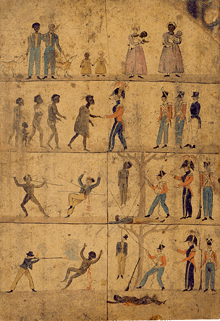
oil on wood, 33 x 22.5 cm
In Van Diemen's Land in November 1828, amid a climate of frontier violence and in response to settler pressure, Lieutenant Governor Arthur declared martial law against the 'Black or Aboriginal natives' within the settled districts of the island.[8] About three months later, on 4 February 1829, George Frankland, the Surveyor General of the colony, suggested to Governor Arthur that communication with Aboriginal people might be made possible through pictures.[9] He wrote to Arthur:
In the absence of all successful communication with these unfortunate people with whose language we are totally unacquainted, it has occurred to me that it might be possible to impart to them to a certain extent, the real wishes of the government towards them ... It is at best an experiment, but as it will be attended by neither expense nor inconvenience, your Excellency may consider it worth trying.[10]
Aboriginal groups in frontier areas conducted strategic, successful, guerrilla-style resistance fighting against settler incursions into their lands. Settlers responded in kind, often with even greater violence, and this period is referred to as the Black War (1824–31). Arthur's desperate solution was for 'the earnest and hearty cooperation of the whole of European population to capture them, with least possible destruction of life, or to drive them into Tasman's Peninsula'.[14] As is now well known, a six-week military-style campaign by the British, commonly referred to as the Black Line, was waged from 7 October to 24 November 1830.[15] The Black Line was considered to be a failure, with the capture of only two Aboriginal people. Later, Arthur lamented that a treaty should have been made between Aboriginal people and the British crown.[16]
The proclamation boards were therefore made during a period of charged contact and frontier violence, between the 1828 declaration of martial law and the Black Line of 1830, which required a further declaration of martial law. They represented, at least in theory, an aspiration for the best aspects of British jurisprudence and have been popularly viewed as 'conciliation' boards. However, as legal scholar Desmond Manderson argues regarding the boards' essential message, Aboriginal people were offered protection though the rule of law but only in exchange for a radical transformation to European ways. It was thus a case of equal justice deferred. The boards were distributed to Aboriginal people in the very midst of frontier conflict; they are constitutive of colonial relations at the time, not artistic reflections of them made at a later date. As I have argued elsewhere, the imagery on the boards promised a harmonious future that was never to become reality; nevertheless, they should be viewed as instruments of diplomacy, despite their failure to effect a conciliation.[17]
Mace's pottery works were largely small-scale domestic wares. As Glenda King relates, prior to Mace's trip to England her pottery reflected the influence of Poynter, as shown in her use of strong colours and painted and incised decorations, although these were 'less exuberant than those of Poynter'.[20] From about 1937, however, a departure from Poynter's influence is apparent in Mace's work when her forms became 'simpler and colours more subdued'.[21] Poynter's and Mace's earthenware works are reflective of the time and context in which they were made. Much Tasmanian early nineteenth-century colonial pottery had been crude and utilitarian due to the difficulty of obtaining clay and glazes. Even by the early twentieth century, equipment and materials required for refined studio work were expensive and hard to acquire. Many potters dug their own clay and made their own glazes. Poynter tested local clays and her own glazes, but her experiments demonstrated that it was more advantageous to purchase clay from Launceston and glazes from Wenger's, Stoke-on-Trent, in England.[22] In studios such as Ratho, much small-scale domestic ware was made of earthenware, owing partly to the constraints of the clay type and the wood- and coke-fired kilns available at the time. It was not until 1928, for example, that Sydney potter Vi Eyre owned and used a gas kiln — one of the first Australian potters to do so.[23]
During her career Mace exhibited regularly in Tasmania, Victoria and New South Wales. She showed her work annually with the New South Wales Arts and Crafts Society from 1927 to 1942. The Museum of Applied Arts and Sciences (Powerhouse Museum) purchased her work from the society's exhibitions of 1928 and 1929, and the Art Gallery of New South Wales acquired examples in 1927 and 1929.[24] During the inter-war period, Mace, Poynter and others such as potter Mylie Peppin and china painter Mildred Lovett were influential artists and teachers, and are considered to have been role models for future generations of women artists and potters in Tasmania. They were significant contributors to the arts and crafts movement in Tasmania and to a foundational and vibrant period of studio pottery there and throughout Australia.[25]
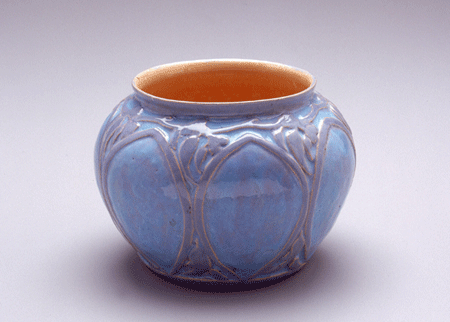
by Violet Mace, Boswell, Tasmania
Although reflective of a wider and growing trend occurring on the mainland during the 1930s, such adaptations in Tasmania were innovative. By this time, many non-Indigenous artists on the mainland had begun to adapt Australian Aboriginal designs and motifs in their work, notable examples being Margaret Preston, Carl Cooper and exhibitors at the Arts and Craft Society of New South Wales, including Grace Seccombe, Nell Holden and Olive Nock.[30] Although some have described this process as one of cultural appropriation or even exploitation, for other non-Indigenous artists it was a 'new way of seeing', as Freeland suggests, and much in line with changing social and political movements of the early twentieth century, which took a more progressive view of Aboriginal people and their culture. A dish made in 1942 with a stylised decoration of a figure playing a didjeridu is typical of this work by Mace (Fig. 4).
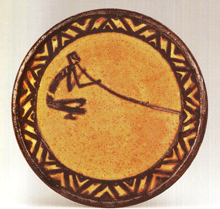
by Violet Mace
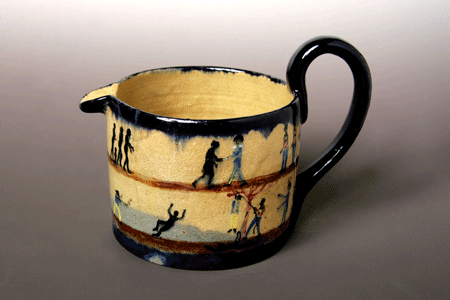
by Violet Mace
Like the cup, the jug is made from hand-thrown earthenware and its painted detail appears to have been executed with a quick, loose hand. The simple forms, slightly rough quality and quickly applied decoration of both these pieces suggest that they may have been made for the tourist market. Few public collections appear to hold examples of works inspired by or depicting the proclamation themes. Indeed, the cup and jug are rare, although examples are undoubtedly held in private collections.[32] I suggest that the cup and jug and related items were not judged by contemporary collectors to be examples of serious, refined artistic output, but may instead have been viewed as tourist ware, and therefore of less apparent significance and value, explaining their under-representation in major collections. Although the value at auction of such historically themed objects has risen considerably in the past decade or so, collectors have generally been slow to recognise the significance of Mace's ceramic works inspired by the colonial past.
Mace and Poynter looked to contemporary themes as well as to the past for inspiration. As King notes, Poynter's work was colourful and often featured animals, plants and her own interpretations of contemporary events.[33] The Tasmanian Museum and Art Gallery holds a vase made by Poynter in 1929 depicting a polar bear looking up at a plane flying over an icy landscape, apparently commemorating Australian Hubert Wilkins' first flight over the Antarctic continent in 20 December 1928, an event that attracted much publicity at the time. Wilkins had previously completed the first flight across the Arctic.[34] Poynter also looked to the past for historically inspired designs. A lidded jar made in 1924 exhibits gargoyle handles, the design having been taken from a manuscript in the British Museum.[35] It seems such works sold well: an article by the Hobart Mercury featuring Poynter's first exhibition in 1924 noted 'there is good demand for the work'.[36]
Poynter and Mace sold their ceramic works to the public from the Ratho studio and at two venues in Hobart: Sarginson's jewellery shop and Jean Spong's art gallery.[37] In 1920s Hobart, jewellery shops were a prime location for the sale of decorative and tourist ware. Harold Sarginson, one of Tasmania's best-known silversmiths, also sold finely made souvenir teaspoons depicting the map of Tasmania and historic themes. The Mercury ran many advertisements for merchants, including jewellers, promoting 'remembrance gifts and souvenirs' and 'souvenirs of Tasmania', including 'Blackwood novelties, shell spoons, Tasmanian maps, design brooches, pens, pencils, saltspoons [and] crest china'.[38] It is likely that Mace's ceramic work was 'bread and butter' pottery — that is, painted and glazed earthenware, decorated with contemporary and historical themes, for local and tourist markets.
The commemorative cup or mug form has long been ubiquitous in popular tourist culture. Along with the tourist teaspoon, and the cup and milk jug or tea set, the cup's souvenir and memorialising functions are simultaneously made popular by their affordability, portability and domestic functionality. The Powerhouse Museum and National Museum of Australia each holds a large range of commemorative cups. Australian examples from around the late nineteenth and early twentieth centuries include commemorative ceramic cups and mugs displaying themes of colonial and international exhibitions, empire and nation, such as the Sydney Exhibition of 1879 cup by Thorpe and Davis, Staffordshire; a 1901 Australian Federation mug by Doulton and Co.; a mug marking the opening of the Sydney Harbour Bridge in 1932; and a cup commemorating the coronation of King George VI and Queen Elizabeth in 1937 (maker unknown). Yet Mace's themes were not based on those of royalty or nation. Her proclamation cup and jug are distinctive: they embody a popular ceramic commemorative form, but are decorated with dramatic, local colonial images that, as we shall see, were in circulation but not always well understood, and with origins that were often misrepresented.
John Freeland credits Mace with a synthesis in her work, including a move toward 'Bernard Leach's theories of folk art and pottery and her awareness of the Australian landscape, Tasmanian European/Aboriginal history and Aboriginal culture'. He cites Mace's jug depicting 'Proclamation to the Aborigines', her later work from central Australia, as well as her use of subdued colours and 'abstracted figures and insects applied in dark iron oxides', describing these as 'motifs which if not directly Aboriginal ... are identifiably influenced by the styles and natural colour palette of Aboriginal representation'.[39] Freeland, however, does not comment on the distinctiveness of Mace's proclamation–inspired works, and tends to view them generally within the broader context of her appreciation of Aboriginal art and design. Yet the proclamation jug (1928), for example, was made at least six years before Mace's trip to central Australia. Her proclamation cup and jug were not in any sense concerned with traditional Aboriginal culture or design. Instead they were decorated with the charged colonial imagery of contact and conflict, and their specific use in time and place is of special interest.
The lithographs were widely distributed. Another print run was made for the Paris International Exhibition, or Exposition Universelle, of 1867. At such exhibitions European powers and their colonies promoted themselves and their most elevated attempts at jurisprudence to each other and the world. The title 'Governor Davey's Proclamation to the Aborigines of Tasmanian 1816' is therefore a historical misattribution perpetuated since the 1866 lithographs and replicated by Mace in her cup and jug.
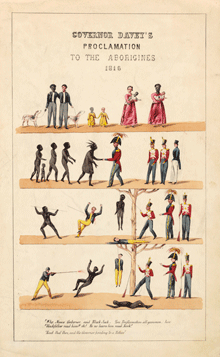
produced for the Intercolonial Exhibition, Melbourne, 1866
The first Alexander Reid had arrived in the Bothwell area in 1822. Reid had been granted land on the Clyde River, naming part of his property 'Ratho' after his original family property near Edinburgh. In 1830 Reid took part in the Black War against Tasmanian Aboriginal people. Governor Arthur had positioned troop depots at frontier hotspots, including the town of Bothwell, to deter Aboriginal people from passing through the settled districts. Settler fear and anxiety was intense, and some were so fearful they sought to give up their land grants. In February 1830, settlers of the Clyde met and petitioned the government, claiming that 'Aborigines were threatening the extinction of the colony itself by firing crops and dwellings'.[49] As Ellis concludes, between 1822 and 1831 'Big River people killed around 60 Europeans, raided huts for weapons, blankets and stores, speared stock, burnt haystacks, huts, fences and homes, and annexed or raised grazing areas. About 240 Aborigines were killed by Europeans and less than sixty remained by 1831'.[50]
While many referred to the Black Line as a failure — a military operation that had captured few Aboriginal people — it did, however, force Aboriginal groups into the north-east of the island. Settlers from Bothwell and Brighton sent congratulations to Lieutenant Governor Arthur for these efforts. After the Black Line, much of the conciliation effort was left to George Augustus Robinson and his 'friendly mission', as has been well documented. Robinson had taken the post of 'Protector of Aborigines' in Van Diemen's Land early in 1830. From October to December 1831 he moved through central Tasmania searching for the feared Big River and Oyster Bay groups, who had terrorised the settled districts. When Robinson and his Aboriginal negotiators finally made contact with the Big River tribe on 31 December, only 24 of its people remained.[52] Robinson met with these war-weary Aboriginal people near Lake Echo and persuaded them to travel to Hobart with him. On their way there they performed a final corroboree outside the Castle Hotel in Bothwell in January 1832. As historian NJB Plomley notes, Robinson's return to Hobart with these Aboriginal people was 'a Roman triumph'. They were paraded through the streets to the strains of a military band, and hundreds of settlers came to see them. The so-called conciliation of the Big River tribe, in reality an Aboriginal surrender into government protection, was the final chapter in Robinson's 'friendly mission' and marked the end of the Black War, at least in the minds of settlers.[53] Over the course of the 'friendly mission', Robinson had persuaded several groups of Aboriginal people to relocate to the Flinders Island mission in the Bass Strait. Yet, by late 1847 this virtually captive group had dwindled to a mere 47 people, who were then moved on to the Aboriginal settlement at Oyster Cove, on the main island of Tasmania.[54]
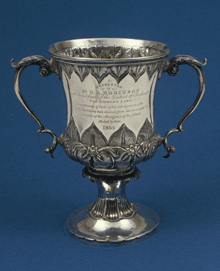
by David Barclay, Hobart
The governor warned these unlettered savages by printed proclamation, that they must stay in the desolate region officially appointed for them! The proclamation was a dead letter; the savages could not read it. Afterwards a picture-proclamation was issued.[68]
Twain cited Bonwick's The Last of the Tasmanians as one of his sources, but it is tempting to think that he may have visited Beattie's museum during his short stay in Hobart.
The manufacture of lantern slides and postcards of the proclamation boards by the turn of the twentieth century is testament to the enduring currency or resonance of these images within tourist circles.[69] Local exhibitions also sought to reproduce the images. In 1931 the Art, Antique and Historical Exhibition in Hobart made a reproduction of the lithograph in a smaller format and also included it in the exhibition and catalogue, attributed to Governor Davey.[70]
Mace's cup and jug are best understood within a series of derivates and reworkings — an established visual vernacular — that emerged from the original proclamation images over the nineteenth and early twentieth centuries, testament to the enduring resonance of the proclamation imagery in the popular imagination, especially in Tasmania. The transference and distribution of historical imagery in various media, including lithography, glass lantern slides, postcards and three-dimensional ceramic ware, suggests much about intended audiences in the late nineteenth and early twentieth century. While the original boards were aimed at local Aboriginal people and convicts, and promoted the idea of equal application of the law and Indigenous transformation, the 1866–67 lithographs produced for the Melbourne Intercolonial and the Paris Universelle exhibitions were intended for an entirely different intercolonial and international audience. These were audiences to which the colony of Tasmania sought to emphasise perhaps a retroactive British jurisprudence and a humanitarian disposition towards its colonised Indigenous people.[72] The attribution of the original date of the images to Governor Davey (1816) also tends to backdate the violent history of the colony, placing it even further in the past. By the 1890s Beattie used glass lantern slides at his lectures for local and international tourist audiences for a purpose that was both entertaining and didactic; and by the early twentieth century the development of portable and cheaper postcards suggests a large and popular circulation of the proclamation imagery to visitors and tourists. By the time Beattie donated his boards to the Mitchell Library and the National Library of Australia, he was clearly aware of their historical significance and value to the general public. The reprint of the imagery for the 1931 Art, Antique and Historical Exhibition in Hobart suggests that the iconography was, by this time, of significant artistic and historical interest, notwithstanding ongoing confusion over attributions.
The proclamation cup and related works are nevertheless part of a rich visual vernacular that was well established in local Tasmanian circles; shown and distributed at inter-colonial and international exhibitions and in popular international texts, such as Dilke's Greater Britain and Bonwick's The Last of the Tasmanians; and authored and promoted by a growing Tasmanian tourism industry in the late nineteenth and early twentieth centuries. The enduring currency of the proclamation images revealed in the making of the cup and other derivative works is of great interest in terms of commemoration and the historical imagination of a local settler community, where contact history comes to be remembered or misremembered in specific ways. Bothwell, a key place of frontier conflict, and the property Ratho are significant as sites for the production of these themed objects — the cup and jug — where Mace's personal and public investments may be found.
While Violet Mace was clearly influenced by and central to a ceramic arts movement that incorporated Aboriginal art and design, her proclamation ceramics reveal an important and innovative departure from usual themes of nationalistic Australiana, royal and national commemorations, or Aboriginal art. Rather, Mace looked to local, charged colonial imagery of Tasmania's past. Her cup and jug reside within the complex intersections of local and colonial history, settler remembrance and Tasmania's emergent ceramics arts movement and growing tourism industry of the late nineteenth and early twentieth centuries.
This paper has been independently peer-reviewed.
1 This paper is dedicated to my friend and well-known Hobart potter, the late John Bartram. Thanks to the National Museum of Australia, Museum Victoria, and Tasmanian Museum and Art Gallery for their continuing support as partners in the Australian Research Council linkage project, 'Conciliation narratives and the historical imagination in British Pacific rim settler societies', with chief investigators Professor Kate Darian-Smith and Dr Julie Evans of the University of Melbourne. I also thank the anonymous reviewers for comments on this paper.
2 For more on Violet Mace (1890–1968) see: G King, 'Violet Mace' and 'Studio pottery in Tasmania', in K Fahey, J Freeland, K Free & A Simpson (eds), Australian Art Pottery 1900–1950, Casuarina Press, Sydney, 2004; C Ackland & C Campbell, 'Pioneer craftswomen from the Bothwell area', Tasmanian Historical Research Association Papers and Proceedings, June 1994, 85–8; J Bartram et al., Early Tasmanian Pottery 1920–1950, exhibition catalogue, Tasmanian School of Art, TCAE, Hobart, 1979. Institutions that hold Mace's works include the Powerhouse Museum, Sydney; Art Gallery of New South Wales, Sydney; Queen Victoria Art Gallery and Museum, Launceston; Tasmanian Art Gallery and Museum, Hobart; and the National Museum of Australia, Canberra.
3 J Freeland, 'Indigenous reference in Australian pottery: Appropriation, adaptation and abstraction', in Australian Art Pottery 1900–1950, p. 49.
4 J Kerr, 'Colonial quotations: Reinventing the original', Art and Australia, vol. 33, no. 3, 1996 (pp. 380, 387)
5 For background on the proclamation boards see: J Morris, 'Notes on a message to the Tasmanian Aborigines in 1829, popularly called "Governor Davey's Proclamation to the Aborigines, 1816"', Australiana, vol. 10, no. 3, August 1988, 84–7; L Ryan, Aboriginal Tasmanians, Allen and Unwin, St Leonards, NSW, 1996; D Manderson, 'Not yet: Aboriginal people and the deferral of the rule of law', Arena, vol. 29, no. 30, 2008, 220–72; P Edmonds, '"Failing in every endeavour to conciliate": Governor Arthur's proclamation boards to the Aborigines, Australian conciliation narratives and their transnational connections', Journal of Australian Studies, special issue on visual culture (forthcoming, 2011).
6 For more on Tasmania's tourism industry see: MJ Walker, 'Memories and dreams: the evolution of Tasmania's tourist image, 1803–1939', PhD thesis, University of Tasmania; J Davidson & P Spearritt, Holiday Business: Tourism in Australian since 1870, Melbourne University Press, 2000.
7 See Australian Research Council linkage project, 'Conciliation narratives and the historical imagination in British Pacific rim settler societies', 2007, section E.
8 Governor's Proclamation, 1 November 1828, British Parliamentary Papers, Colonies, Australia, Shannon, 1970, vol. 4 (pp. 184, 192). Lieutenant Governor George Arthur took up office in Hobart, Van Diemen's Land, in May 1824. He left Hobart on 30 October 1836. See AGL Shaw, 'Arthur, Sir George (1784–1854)', Australian Dictionary of Biography, vol. 1, Melbourne University Press, 1966, pp. 32–8.
9 See PR Eldershaw, 'Frankland, George (1800–38)', Australian Dictionary of Biography, vol. 1, pp. 410–11.
10 Letter from Frankland to Arthur, 4 February 1829, Tasmanian Archive and Heritage Office (TAHO), LSD 17/1.
11 Letter from Frankland to RW Hay, 9 February 1829, in Five Letters from George Frankland in Van Diemen's Land, Nag's Head Press, Adelaide, 1997.
12 A letter from the Commandant at Launceston, Major Abbott, to the Colonial Secretary, 30 August 1830, cited in NJB Plomley (ed.), Friendly Mission, p. 108, notes: 'I endeavoured to explain to the natives the figures on the boards, which you forwarded to me; and shook hands with them on parting; they appeared all well disposed and friendly; one board I gave to the Circular Head Party, and the other to Captain Welsh's party'.
13 Lieutenant Governor Arthur, Despatch to Sir George Murray, Colonial Secretary, 20 November 1830, microfilm, TAHO.
14 ibid. For background on conflict and contact between Aborigines and settlers in colonial Van Diemen's Land see: NJB Plomley, The Aboriginal/Settler Clash in Van Diemen's Land 1803–1831; Plomley (ed.), Friendly Mission: The Tasmanian Journals and Papers of George Augustus Robinson, 1829–1834; L Ryan, Aboriginal Tasmanians, Allen and Unwin, St Leonards, NSW, 1996; H Reynolds, Fate of a Free People: The Classic Account of the Tasmanian Wars, Penguin, 2004; P Chapman (ed.), Historical Records of Australia Series III Despatches and Papers Relating to the History of Tasmania, Vol. VIII, Melbourne University Press, 2003. Nineteenth-century works include: H Melville, The History of Van Diemen's Land: From the Year 1824 to 1835, Sydney, 1836, rev. edn, George Mackaness (ed.), Horwitz-Grahame, Sydney, 1965; J Bonwick, The Last of the Tasmanians: or, The Black War of Van Diemen's Land, Sampson Low, Son, & Marston, London, 1870.
15 J Connor, 'British frontier warfare logistics and the "Black Line"', War in History, vol. 9, no. 2, 143–58. The campaign's goal was to capture or force Aboriginal people into the Forestier and Tasman peninsulas. For this purpose Arthur had collected around 2200 men, 550 of whom were troops, the rest being willing civilians, ibid., p. 150.
16 Letter from Governor Arthur to Secretary Hay, September 1832, in M Bassett, 'Governor Arthur and the opposite coast', Tasmanian Historical Association, vol. 2, no. 5, 1953 (p. 90).
17 See D Manderson, 'Not yet'; P Edmonds, 'Failing in every endeavour to conciliate', pp. 1–3.
18 King, 'Violet Mace', Australian Art Pottery 1900–1950, p. 238.
19ibid.; C Ackland & C Campbell, 'Pioneer craftswomen from the Bothwell area'; King, 'Studio pottery in Tasmania', Australian Art Pottery 1900–1950; J Bartram et al., Early Tasmanian Pottery 1920–1950.
20 King, 'Violet Mace', p. 238.
22 King, 'Tasmanian ceramics: An historical perspective', Pottery in Australia, vol. 26, no. 3, August 1987 (p. 7).
23 P Timms, Australian Pottery 1900 to 1950, exhibition catalogue, Shepparton Arts Centre, 1978, p. 11.
24 Timms, 'Violet Mace', Dictionary of Australian Artists Online.
25 King, 'Studio pottery in Tasmania', p. 33.
26 Ackland & Campbell, 'Pioneer craftswomen of the Bothwell area' (p. 87).
27 ibid. See also C Miley, Beautiful and Useful: The Arts and Crafts Movement in Tasmania, exhibition catalogue, Queen Victoria Art Gallery and Museum, Launceston, 1987, p. 41.
28 Timms, 'Violet Mace'.
29 King, 'Studio pottery in Tasmania', p. 36.
30 See Freeland, 'Indigenous reference in Australian pottery: Appropriation, adaptation and abstraction', Australian Art Pottery 1900–1950, p. 51.
31 King, 'Violet Mace', pp. 238–41.
32 Ackland & Campbell relate that few examples of her work remain in Tasmania as 'she left most of it to a relative in New Zealand' (p. 87). Likewise, few small museums in Tasmania hold Mace's ceramic work. The Swansea Museum holds some works, while Bothwell Historical Society has none.
33 King, 'Maude Poynter', Australian Art Pottery 1900–1950.
34 Earlier in April 1928 Wilkins had completed the first trans-Arctic flight from Alaska to Spitzbergen.
35 Miley, Beautiful and Useful, p. 43.
36 King, 'Studio pottery', p. 35.
37 Timms, 'Violet Mace'.
38 See advertisements: Charles David Ltd. Hardware merchant Hobart, Mercury, 7 January 1924; F.A. Flint Watchmakers and Jewellers, Liverpool Street, Hobart, Mercury, 7 January 1924. See also K Cavil, 'Commemorative and souvenir spoons of Australian interest, 1894–1994', Australiana, November 1994, pp. 95–106, 97.
39 Freeland, p. 52.
40 C Craig, Engravers of Van Diemen's Land, Tasmanian Historical Research Association, Hobart, 1961, pp. 146–7.
42 Timms, Australian Pottery 1900 to 1950, p. 11.
43 For further reference to Violet Mace and Maude Poynter's work see Miley, Beautiful and Useful.
44 Ackland & Campbell (p. 86).
45 S Ellis, Bothwell Revisited: A History: Foundation Federation and the Millenium, Bothwell Historical Society Inc., 2001, pp. 1, 4.
46 ibid., p. 2.
47 The land was in two sections: 1400 acres (576 hectares) which he called Ratho, and 600 acres (243 hectares), five miles (8 kilometres) downstream, which he named Humbie. See AF Pike, 'Reid, Alexander (1783–1858)', Australian Dictionary of Biography, vol. 2, Melbourne University Press, 1967.
48 15April 1828, in Ryan, Aboriginal Tasmanians, p. 97.
49 See H Reynold, Fate of a Free People, pp. 59, 61.
50 Ellis, Bothwell Revisited, p. 2.
51 Ryan, p. 112.
52 ibid., p. 158. See also: Plomley, 'Robinson', ADB online; 'Robinson, George Augustus (1791–1866)', Australian Dictionary of Biography, vol. 2, Melbourne University Press, 1967, pp. 385–87. For new reflections on the 'friendly mission' see also A Johnston & M Rolls, Reading Robinson, Quintus, Hobart, 2008.
53 'Robinson', ADB online;V Rae-Ellis, Black Robinson, Melbourne University Press, 1996, p. 80; Ellis, p. 2.
54 Ryan, p. 203.
55 'Robinson', ADB online and Australian Dictionary of Biography.
56 Hobart Town Courier, 8 April 1836.
57 ibid. The Robinson cup is held in the collections of the Queen Victoria Museum and Art Gallery, Launceston.
58 On these properties of colonial objects more generally see C Healy, 'Chained to their signs: Remembering breastplates', in B Creed & J Hoorn (eds), Body Trade: Captivity, Cannibalism and Colonialism in the Pacific, Routledge in association with Pluto Press and University of Otago Press, 2001, pp. 24–35.
59 The Conciliation is in the collections of the Tasmanian Museum and Art Gallery. For more on the painting see B Attwood, Possession: Batman's Treaty and the Matter of History, Melbourne University Press, Melbourne, 2009.
60 J Bonwick, Last of the Tasmanians: or, The Black War of Van Diemen's Land, Sampson Low, London, 1870. On Bonwick and the conciliation see also Attwood, Possession; Dilke, Greater Britain: A Record of Travel in English-Speaking Countries During 1866 and 1867, 2 vols, Macmillan and Co., London, 1868.
62 See P Edmonds, 'We think that this subject of the native races should be thoroughly gone into at the forthcoming Exhibition': The 1866-67 Intercolonial Exhibition', Seize the Day: Exhibitions, Australia and the World, Kate Darian-Smith, Richard Gillespie, Caroline Jordan and Elizabeth Willis (eds), (Melbourne: Monash University Press, 2008), pp. 4–15. It is unlikely, however, that Mace had ever seen this silver cup as it was not until the early 1940s that Australian historian Philip L Brown recovered the cup and a range of Robinson's material from Bath, England, and later donated these items to several Australian collecting institutions. 'The Ethnographic Collection of George Augustus Robinson', Memoirs of the Museum of Victoria, vol. 1, no. 1, 1990, pp. 1–96, 23.
63 See also Davidson & Spearritt, Holiday Business.
64 L Robson, A History of Tasmania, vol. 2, Oxford University Press, 1990, p. 168; see also M Roe, 'Beattie, John Watt (1859–1930)', Australian Dictionary of Biography, vol. 7, Melbourne University Press, 1979, pp. 232–33.
65 The State Library of Victoria, H6550. Some of these images were probably copies of photographs made from originals taken by Francis Russell Nixon in the 1850s and by Charles A Woolley in 1866. See also 'Introduction', in M Tassell & D Wood, Tasmanian Photographer: From the John Watt Beattie Collection, QVMAG, Launceston, 1981.
66 Roe, 'Beattie, John Watt (1859–1930)', Australian Dictionary of Biography.
67 See 'Governor Davey's Proclamation to the Aborigines, 1816', R247, State Library of New South Wales.
68 M Twain, The Wayward Tourist: Mark Twain's Adventures in Australia, Melbourne University Press, 2006, pp. 152–53. These are excerpts from Twain's book Following the Equator: A Journey around the World (1897).
69 The State Library of Victoria holds a lantern slide, dated about 1900–25, taken from the original pen-and-ink drawing for the 1866 lithograph now held in the National Library of Australia. This institution also holds a postcard from the AC Dreier postcard collection made from the same image, dated 1926, again attributed to Governor Davey.
70 Thanks to George Burrows, Tasmania, who provided this information. Also reproduced in [Catalogue of] Art, Antique and Historical Exhibition [Held in] City Hall, Hobart, August 27th to September 5th, 1931, Cox Kay, Hobart, 1931 (see State Library of Tasmania).
71 Letter (undated) to Miss Mace from the Director, presumably of Tasmanian Museum and Art Gallery, collection archives of TMAG.
72 For an extended discussion of the placement and use of the lithographs in the 1866 and 1867 exhibitions see Edmonds, 'We think that this subject of the native races should be thoroughly gone into at the forthcoming Exhibition'.
73 See, for example, C Healy, From the Ruins of Colonialism: History as Social Memory, Cambridge University Press, 1997.
74 Morgan & Pritchard, 'On souvenirs and metonymy: Narratives of memory, metaphor and materiality', Tourist Studies, vol. 5, no. 1, 29–53.
